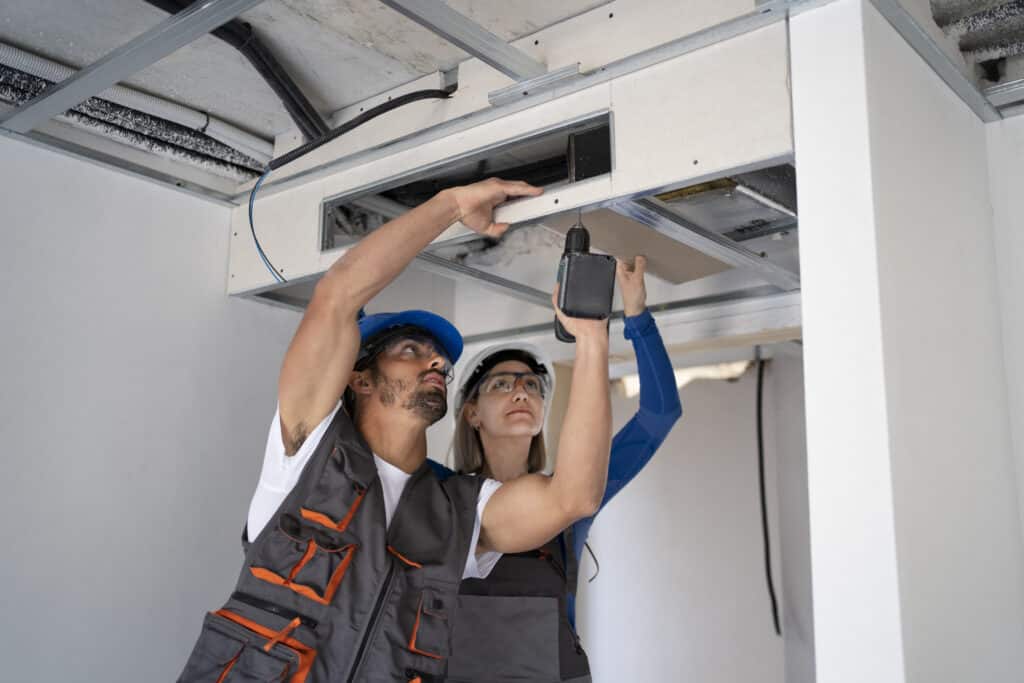Microorganisms in HVAC systems encompass a wide array, including bacteria, viruses, fungi, and mold. They thrive in the damp and dark environments commonly found in HVAC components, posing potential threats to both system functionality and indoor air quality. We prioritize not just the comfort but also the health of your indoor spaces. In this comprehensive blog post, we shed light on the microscopic world – microorganisms. Understanding the types of microorganisms affecting HVAC systems is crucial for implementing effective preventive measures. Let’s look into the unseen threats lurking within your HVAC infrastructure.
Types of Microorganisms in HVAC Systems
Microorganisms in HVAC systems encompass a wide array, including bacteria, viruses, fungi, and mold. They thrive in the damp and dark environments commonly found in HVAC components, posing potential threats to both system functionality and indoor air quality.
1. Bacteria
Bacteria, though small, can have a big impact on your HVAC system. These single-celled organisms thrive in damp and dark environments, making components like drip pans, coils, and drain lines ideal breeding grounds. Bacterial growth can lead to the formation of biofilms, slimy layers that obstruct air pathways, reducing the system’s efficiency. The consequences of unchecked bacterial growth can extend from increased energy consumption to system breakdowns.
2. Viruses
While viruses are more commonly associated with human health concerns, they can also pose risks within HVAC systems. Airborne viruses may circulate through the system, potentially spreading illnesses. Their small size allows them to travel with ease, making proper air filtration crucial to prevent their infiltration and transmission.
Suggested Read: How to Properly Maintain HVAC Filters?
3. Fungi and Mold
Dark, damp HVAC components can become breeding grounds for fungi and mold. Once these microscopic spores take hold, they can cause blockages, emit unpleasant odors, and compromise indoor air quality. Additionally, prolonged exposure to mold spores may pose health risks, triggering respiratory issues and allergies in occupants.
Effects of Microorganisms on HVAC Systems
Microorganisms can exert a range of detrimental effects on HVAC systems, impacting efficiency and air quality.
1. Reduced Efficiency:- Accumulation of microorganisms can obstruct air pathways, reducing the efficiency of heat exchange components. This results in increased energy consumption and higher utility bills.
2. System Breakdowns:- Biofilm formation, a common consequence of bacterial growth, can lead to clogs and corrosion. This compromises the structural integrity of HVAC components, potentially causing system breakdowns.
3. Unpleasant Odors – Mold and fungi emit distinct odors that can permeate indoor spaces, creating discomfort and indicating potential problems within the HVAC system.
4. Health Concerns – Airborne microorganisms, including bacteria and viruses, can affect indoor air quality, posing health risks for occupants. This is particularly significant in commercial spaces, where the spread of airborne contaminants is a critical concern.
5. Blocked Air Passages – Biofilm and microbial growth can obstruct air pathways, diminishing the system’s ability to circulate conditioned air efficiently.
6. Corrosion – Microbial activity can contribute to corrosion within HVAC components, accelerating wear and tear and reducing the lifespan of the system.
7. Increased Energy Consumption – Reduced efficiency due to microbial growth forces the HVAC system to work harder, leading to increased energy consumption and higher operational costs.
8. Indoor Air Quality Issues – Microorganisms can degrade indoor air quality, triggering allergies, respiratory issues, and other health concerns among occupants.
Solutions for Maximizing HVAC Efficiency
Addressing the impact of microorganisms on HVAC systems requires a multifaceted approach to ensure optimal efficiency and air quality. Encourage practices such as regular filter replacement and prompt reporting of any signs of issues to facility management, fostering a collaborative effort in ensuring optimal system performance and indoor air quality.
Regular Maintenance
Conduct thorough inspections and cleaning of HVAC components, including coils, filters, and drain pans, to prevent the accumulation of dust and microbial growth. Schedule routine professional check-ups to identify and address potential issues before they escalate, ensuring the system operates at peak performance.
Advanced Filtration Systems
Explore the benefits of High-Efficiency Particulate Air (HEPA) filters, which can trap smaller particles, including microorganisms, and enhance the overall air filtration capability. Consider the installation of Ultraviolet (UV) filters, which use UV-C light to deactivate the DNA of microorganisms, preventing their reproduction and spread.
Humidity Control
High humidity levels affect the HVAC system’s performance. Monitor and control humidity levels within HVAC systems to maintain an environment inhospitable to the growth of fungi and mold. Integrate smart humidity control systems that adjust levels based on environmental conditions, preventing both excessive dryness and moisture.
Duct Cleaning
Implement a comprehensive duct cleaning schedule to remove accumulated dust, debris, and microbial contaminants, ensuring unobstructed airflow and preventing the spread of pollutants. Utilize advanced cleaning techniques, such as robotic duct cleaning systems, to reach inaccessible areas and maintain the cleanliness of the entire ductwork.
UV-C Light Installation
Install UV-C light devices strategically within the HVAC system to target microbial contamination in key areas, such as cooling coils and drain pans. Ensure proper calibration and maintenance of UV-C lights to maximize their effectiveness in neutralizing bacteria and viruses.
Airflow Optimization
Regularly inspect and adjust the airflow in the HVAC system to ensure proper distribution of clean air throughout the building. Consider the installation of variable speed drives (VSDs) to modulate fan speeds based on demand, improving energy efficiency and maintaining consistent airflow.
Seal and Insulate Ductwork
Address leaks and gaps in ductwork to prevent the infiltration of contaminants from unconditioned spaces, enhancing the overall efficiency of the HVAC system. Properly insulate ducts to minimize heat transfer and improve the system’s ability to maintain desired temperature levels.
Ready to Ensure a Healthy Indoor Environment?
The impact of microorganisms on HVAC systems is a critical consideration for both efficiency and indoor air quality. Proactive measures, ranging from regular maintenance to advanced filtration systems, are essential for mitigating potential problems and ensuring a healthy and efficient HVAC environment.
At All Seasons Home HVAC, we have experienced technicians that specialize in comprehensive HVAC services, including maintenance, filtration system upgrades, and microbial contamination prevention. Contact us and schedule a consultation to maximize your HVAC system’s performance and the well-being of your indoor space.




